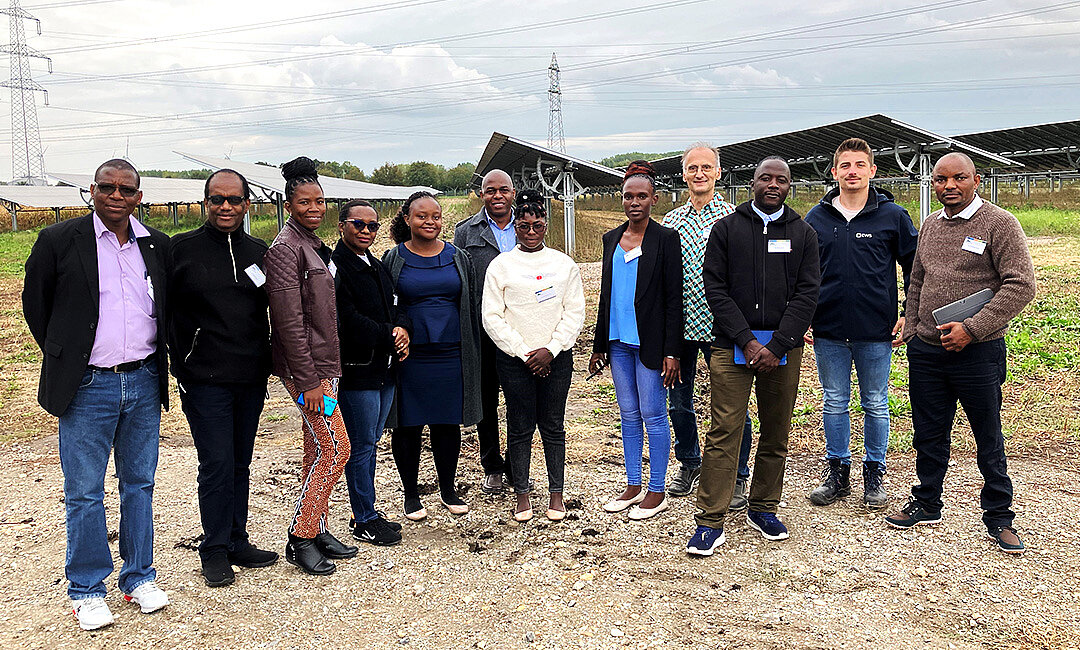
Hauptinhalt
Hauptinhalt
Visit from Tanzania at EWS Sonnenfeld Bruck/Leitha
24.10.2023: African university comes to see for itself

Two students and eight heads of department, including Vice-Rector Dr. John P. John, from the Mbeya University of Science and Technology (MUST) visited the EWS Sonnenfeld Agri-PV plant in Bruck/Leitha.
The visit was arranged by Günter Wind. He has been a lecturer at the Pinkafeld University of Applied Sciences since 2006 for the subjects "Renewable Energy Systems", "Photovoltaics" and "Digitalisation of Energy Systems". He has already been to Tanzania several times, also with students from the FH Burgenland, to implement small energy projects there with the help of donations. This has resulted in a partnership between FH-Burgenland and MUST that has lasted several years. In the future, the partnership is to be expanded with online courses so that students can attend courses at the partner university without travel costs. This is a valuable offer, especially for students in Tanzania.
EWS Sonnenfeld® as a renewable energy concept for Tanzania
"Basically, the need to expand the power supply in Tanzania is enormous. Only about 15 % of the households in rural regions have any electricity at all," says Günter Wind.
MUST wants to expand its know-how and consulting services in the field of renewable energies, so an energy excursion was put together. This included a visit to the EWS Sonnenfeld in Bruck/Leitha.
"The professional interest in the EWS Sonnenfeld Bruck/Leitha, especially with regard to the technical solutions, was great. It would be nice if in the future Agri-PV systems could also generate clean solar power in Tanzania and cotton, tea or sisal could grow between the rows of modules," says Julian Schauerhuber from EWS, who guided the group through the solar field.
Günter Wind has already carried out measurements and evaluations for the use of solar and wind energy and found that in many areas the use of both forms of energy is very attractive. With sun and wind, a functioning renewable energy system could be built there quite easily, together with the already partly used hydropower.
Mbeya in Tanzania
Mbeya is one of the ten largest cities in Tanzania and the capital of the region of the same name in the southwestern highlands of Tanzania at an altitude of 1600 to 1900 metres. Nearly 280,000 people live in Mbeya, and about 2.3 million in the entire region. Mbeya translates as "salt" and refers to the early salt mining. The most important economic sector in the region is agriculture, which employs eighty percent of the workforce. The main exports are gold, coffee, tea, cotton and tobacco.
Mbeya is also known as a gold mining town, as it was founded in the 1920s after the gold rush of 1906. The area was under British administration until 1961. The construction of the TAZARA railway line from 1970 to 1973 attracted many small-scale entrepreneurs and peasant migrants to the area.
Energy remains a major constraint to growth in Mbeya's economy. Less than 20 percent of the population has access to electricity. To solve the problem, the government is counting on higher yields from the developed offshore gas fields in the south of the country, as well as on developing offshore natural gas fields in the south. (Wikipedia)
Am I ready for hectares of solar power?
Request your free land check now!
An area of at least 5 hectares in size should not be a problem. Will it be suitable for agricultural photovoltaics?
I hope so and will do the "area check"!